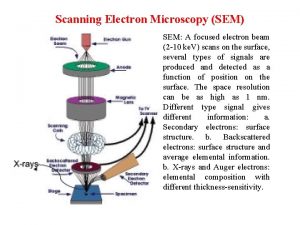Sem Eval2010 Task 8 MultiWay Classification of Semantic

- Slides: 1

Sem. Eval-2010 Task 8 Multi-Way Classification of Semantic Relations Between Pairs of Nominals Iris Hendrickx, Su Nam Kim, Zornitsa Kozareva, Preslav Nakov, Diarmuid Ó Séaghdha, Sebastian Padó, Marco Pennacchiotti, Lorenza Romano, Stan Szpakowicz 1. Task Description The ability to identify relations between entities in a text is a fundamental part of language understanding. Sem. Eval-2010 Task 8 involves classifying which, if any, of nine semantic relations holds between pairs of entities in their sentential context and mapping the entities onto the argument slots of the predicted relation. Many tasks consider relations between named entities (e. g. , ACE, Bio. Creative); we consider general relations between common nouns. We have defined nine relations; the dataset also contains sentences expressing “none of the above” (labelled Other). We build on the successful Sem. Eval-07 Task 4 on Classifying Semantic Relations Between Nominals (Girju et al. , 2007). To develop a more realistic and robust task we have made significant changes: Multiclass task instead of a set of binary tasks. Much larger dataset (10, 000 items versus ~1, 500). 3. Data Collection Each example consists of two (base) NPs marked with tags <e 1> and <e 2>: People in Hawaii might be feeling <e 1>aftershocks</e 1> from that <e 2>powerful earthquake</e 2> for weeks. Relations are asymmetric – here Cause-Effect(e 1, e 2) does not hold, but Cause-Effect(e 2, e 1) does. Three-stage annotation process: (1) Detailed annotation guidelines have been developed for each relation. (2) Data will be collected from the Web using a semi-automatic, patternbased search procedure. The patterns will be chosen in such a way as to ensure that systems cannot simply learn to map patterns to relations. (3) Each example will be labelled by two independent annotators. The examples will be pooled by pattern-associated relation, but the annotators may label them as Other or as any of the alternative eight relations. Systems are not provided with Word. Net annotations; for test examples no mapping of entities to argument slots is provided. 2. Relations Cause-Effect Smoking causes cancer. Instrument-Agency The murderer used an axe. Product-Producer Content-Container Bees make honey. The cat is in the hat. Entity-Origin Vinegar is made from wine. Entity-Destination The car arrived at the station. Component-Whole The laptop has a fast processor. Member-Collection There are ten cows in the herd. Communication-Topic You interrupted a lecture on maths. 4. Dataset and Evaluation Dataset consisting of 1, 000 examples per relation: 700 training, 100 development, 200 testing. Total of 10, 000 examples (9 relations + Other). Data licensed under Creative Commons Attribution Licence 3. 0. Official system ranking by F-score (macro-averaged over nine relations); we will also calculate accuracy on the whole dataset. 5. More Information Task web page: http: //groups. google. com/group/semeval-2010 -multiway-classification-of-semantic-relations Contact: Preslav Nakov (nakov@comp. nus. edu. sg)

